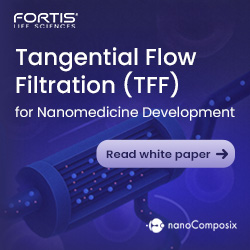Bio Platforms
MD Anderson, Invectys and CTMC Announce Strategic Collaboration for CAR T Cell Therapy Development
The University of Texas MD Anderson Cancer Center, Invectys, Inc., and the Cell Therapy Manufacturing Center (CTMC), a joint venture between MD Anderson and National…
Aptamer Group Signs Deal With Flip Gene Therapeutics to Support the Development of Inducible Gene Therapies
Aptamer Group plc has recently negotiated a deal with the biotechnology company Flip Gene Therapeutics to support its novel, inducible gene therapy platform with the…
Kintara Therapeutics Granted Fast Track Designation for VAL-083 for Newly Diagnosed Glioblastoma
Kintara Therapeutics, Inc. recently announced the US FDA has granted Fast Track Designation (FTD) to Kintara’s VAL-083 for the treatment of patients with newly diagnosed…
Aeterna Zentaris Achieves Proof-of-Concept for the Treatment of NMOSD With AIM Biologicals Program
Aeterna Zentaris Inc. recently announced its Autoimmunity Modifying (AIM) Biologicals program has achieved preclinical proof-of-concept for the potential treatment of neuromyelitis optica spectrum disorder (NMOSD)…
Nuvectis Pharma Announces Positive Data for NXP900 in a Preclinical Model of Group 4 Medulloblastoma, a Type of Brain Cancer That Affects Predominantly Pediatric Patients
Nuvectis Pharma, Inc. recently announced positive data for NXP900 in a preclinical xenograft model of Group 4 Medulloblastoma presented on June 12, 2022, at SIOPE Brain Tumour Group in Hamburg, Germany, by scientists….
Veralox Therapeutics Announces Favorable Results of Phase 1 Studies of VLX-1005 in Development for Treatment of Heparin-Induced Thrombocytopenia
Veralox Therapeutics recently announced favorable results from the company's Phase 1 clinical program for VLX-1005, a novel 12-LOX inhibitor being developed for the treatment and…
Exavir Therapeutics Announces Preclinical Data for Ultra-Long-Acting Dolutegravir Prodrug XVIR-120
Exavir Therapeutics recently announced the publication of preclinical data for XVIR-120, an investigational agent being developed as a long-acting injectable antiviral for HIV….
Replicate Bioscience & Curia Enter Strategic Collaboration to Create Groundbreaking Development Platform for Self-Replicating RNA
Replicate Bioscience and Curia, formerly AMRI, recently announced they will collaborate on a robust development platform for Replicate’s srRNA therapeutics. The strategic collaboration unites….
Catalent & MigVax Sign Agreement to Develop an Orally Disintegrating Freeze-Dried Tablet Vaccine Against COVID-19
Catalent and MigVax recently announced they have signed a development agreement to leverage Catalent’s proprietary Zydis Bio orally disintegrating tablet (ODT) technology for delivering the…
Editas Medicine & Immatics Enter Strategic Research Collaboration & Licensing Agreement to Combine Gamma-Delta T Cell Adoptive Cell Therapies & Gene Editing for the Treatment of Cancer
Editas Medicine, Inc. and Immatics N.V. recently announced the two companies have entered into a strategic research collaboration and licensing agreement to combine gamma-delta T cell adoptive cell therapies and….
ProteoGenix, Aseem Healthcare & Trident Biopharm Solutions Announce New Antibody Cocktail Effective Against Major Variants of SARS-CoV-2
ProteoGenix, Aseem Healthcare, and Trident Biopharm Solutions recently announced the development of a new antibody cocktail effective against major variants of SARS-CoV-2. The cocktail of…
SPECIAL ROUNDTABLE - Which Trends Will Have the Most Impact on Drug Development in 2022?
Drug Development & Delivery posed this question to life science leaders during a recent roundtable discussion. While their responses are varied, a common theme is that COVID-19 has left a lasting impact on the industry….
Curia Adopts the Berkeley Lights Platform to Expand its Antibody Discovery Capabilities
Berkeley Lights, Inc. and Curia recently announced Curia’s adoption of The Beacon Optofluidic system and workflows from Berkeley Lights to accelerate….
Yumanity Therapeutics Announces Definitive Agreements for Two Strategic Transactions
Yumanity Therapeutics, Inc. recently announced it has entered into definitive agreements for two strategic transactions. The first definitive agreement is an asset purchase….
Assembly Biosciences Initiates Phase 1b Clinical Trial Evaluating Next-Generation Core Inhibitor
Assembly Biosciences, Inc. recently announced the initiation of a Phase 1b trial of its investigational next-generation, highly potent core inhibitor ABI-H3733 (3733). 3733 has demonstrated…
Immunocore Announces Clinical Trial Collaboration With Sanofi
Immunocore Holdings Plc recently announced it has entered into a clinical trial collaboration and supply agreement with Sanofi…..
Evonik Invests $220 Million to Build New Lipid Production Facility for mRNA-based Therapies in the US
Evonik is building a new, highly flexible, global-scale production facility for pharmaceutical lipids in the US. The new plant at Evonik’s Tippecanoe site in Lafayette,…
Teon Therapeutics Announces FDA Acceptance of IND Application for Novel, Oral Immune Checkpoint Inhibitor
Teon Therapeutics recently announced the acceptance by the US FDA of Teon’s Investigational New Drug (IND) application for the study of TT-816. TT-816 is a novel, oral cannabinoid CB2 receptor….
PDS Biotechnology Granted FDA Fast Track Designation for Lead Candidate
PDS Biotechnology Corporation recently announced the US FDA has granted Fast Track designation to PDS0101 in combination with Merck’s anti-PD-1 therapy, KEYTRUDA (pembrolizumab). PDS0101 in combination…
Biogen & Samsung Bioepis’ & Biogen's BYOOVIZ (ranibizumab-nuna) Launches in the US
Samsung Bioepis Co., Ltd. and Biogen Inc. recently announced BYOOVIZ (ranibizumab-nuna), a biosimilar referencing LUCENTIS (ranibizumab), has been launched….
What are Bio Platforms?
Platforms (or asset-independent technologies to capture all kinds of capabilities that can be leveraged across many different drug candidate assets rather than just discovery tools that the term ‘platform’ immediately brings to mind) are ubiquitous in modern pharma. They are the product of an arms race, to secure access to the best capabilities in key areas.
Platform technologies are considered a valuable tool to improve efficiency and quality in drug product development. The basic idea is that a platform, in combination with a risk-based approach, is the most systematic method to leverage prior knowledge for a given new molecule. Furthermore, such a platform enables a continuous improvement by adding data for every new molecule developed by this approach, increasing the robustness of the platform.
But it has often been said that access to the latest technological platforms to aid efficient drug discovery and development is limited to Big Pharma, which can more easily justify the costs of creating and operating these platforms.
Benefits of Bio Platforms
Platform technologies have the ability to radically improve upon current products and generate completely novel products. In this sense, they open up new arenas for drug discovery and development, potentially increasing the number of therapeutic options for patients. Once a single compound or therapeutic has been generated and demonstrates a clinical benefit in patients, it is more likely this platform technology can successfully be applied to other therapeutic areas, derisking future compounds/products.
Complex drugs by their very nature are challenging and costly to manufacture. This, in turn, translates into higher costs for patients and other payers. In order to provide safe and effective therapies at a reasonable price, it is necessary for the industry to develop manufacturing technologies that reduce costs and provide a consistent product. While the initial investment may be larger, manufacturing costs will be lower over time as the manufacturing process is solidified.
Scale and Investment of Bio Platforms
Despite the initial upfront costs, platform technologies inevitably provide pragmatic solutions to production challenges, while yielding safer and more effective therapeutic products. It has often been said that one of the key features that distinguishes “Big Pharma” from biotech is access to the latest technological platforms to aid efficient drug discovery and development.
These platforms range from vast chemical libraries, ultra-high throughput screening and huge genetic databases in discovery, to predictive toxicology platforms, cutting-edge ‘omics’ and even deep-seated knowledge of particular therapeutic areas in development. All these platforms have two things in common: They can be used on any (or many) development candidate assets, and they cost huge sums to establish in the first place, and in a few cases each time they are used as well. Hence their restriction to the largest pharmaceutical companies (and a few of the so-called “big biotechs” that are, in many ways, indistinguishable from the old-guard pharma).
Only when you have hundreds of active projects can you justify the cost of creating and operating these platforms. Or so the mantra goes. It is access to these platforms that keeps the big companies ahead in the race to discover and develop the best medicines (or at least counterbalance the disadvantages of being large and slow-moving, depending on your point of view). But is that just an assertion? How much evidence is there to support the proposition that the efficiency gains due to these platforms outstrips the cost of creating and maintaining them?
Keeping these technologies “cutting edge” has become so expensive that increasingly we hear pharma companies talking of “pre-competitive” approaches to develop the next generation. A group of companies might develop a platform capability they then share. The principle goal of such initiatives is to access even grander and more expensive tools than individual companies could afford, rather than to dramatically cut costs (although sharing platforms rather than developing the same thing in parallel in each silo should at least keep a lid on rising costs).
















